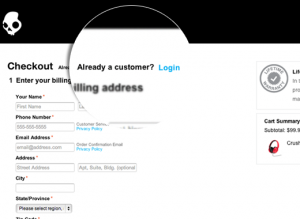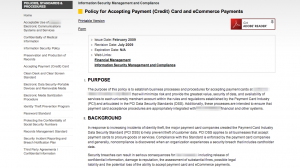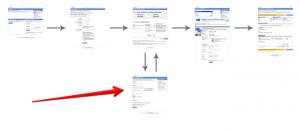Shopping cart abandonment is one of the most frustrating occurrences in ecommerce. It’s also one of the most significant depletions of your profit potential—you’re so close to a sale and yet still so far away.
According to the Baynard Institute, for typical online retailers, the rate of cart abandonment ranges from a little under 60% to just over 80%, with an average of 68.63%. This means that close to seven out of every ten times that a customer places a product into his or her shopping cart, the “add-to-cart” action does not result in a sale.

To combat shopping cart abandonment, you first need to understand the reasons that lead to its happening so you can then implement solutions that will be the most effective.
Why Do Shoppers Abandon Their Online Shopping Carts?
Two of the most commonly cited reasons for why shoppers abandon their shopping carts are 1. a lack of transparency about shipping costs and 2. the prerequisite of creating an account, which feels like an unnecessary step. The list of reasons doesn’t stop at two, however.
Below, we will delve deeper into the aforementioned causes along with numerous ways you can reduce your company’s rate of shopping cart abandonment.
Shockingly High Shipping Costs
According to a ComScore report, “61% [of] consumers are ‘at least somewhat likely’ to cancel their entire purchase if free shipping isn’t involved.” Additionally, a PayPal study found that “43% of shoppers abandoned shopping carts because the shipping charges were too high.”
What’s The Solution?
Offering free shipping can sometimes do the trick; over half of online retailers are already doing this. However, free shipping is not an economically viable option for all e-retailers, especially when it comes to international orders.

What’s more important than the shipping cost itself is being upfront about it. Never try to pull a fast one on your customers. Without a doubt, they will resent you for it. That said, S&H costs should still be kept to a minimum whenever possible.
As a rule, “make sure that your total shipping cost doesn’t exceed more than 20% of the price,” says Betaout. “You can also offer a flat rate shipping on all items or your cost can vary depending on different products and the weight of the items you’re shipping.” Additionally, be sure to list the countries you’re willing to ship to, including whether or not you ship to APO, FPO, and DPO addresses.
Sign-In And Account Creation Frustrations
For many websites, the checkout process starts with a potentially irksome question: “Are you a new or returning customer?” which prompts customers to have to either…
- remember the email address and password they signed up with,
- or decide whether they want to create an account (and complete a series of additional steps) or checkout as a guest.
“Each option creates an unnecessary disconnect between the user and their goal–buying the product,” says Nirav Sheth of Awesome Checkout.
What’s The Solution?
The purpose of creating an account should be to make the checkout process easier and quicker for customers. Therefore, the login process should be integrated with your site so customers both with and without accounts can log in or not log in without having the shopping process feel disrupted. Having a guest checkout option can also significantly reduce the amount of your customer “dropouts.”
Check out the two examples below, both of which effectively integrate the customer login process:


Security Measures That Are Too Intense, Too Laidback, Or MIA
Jeremy Smith of JeremySaid: “I recently came across this gem on a website. It was thousands of words of legal mumbo jumbo that covered their tails in the event of anything legal that could happen involving the use of credit cards on their website:

Okay fine. Target security breach. I get it. But, please, don’t do this to your poor customers. Don’t make it hard for them to pay.”
It’s all about striking an agreeable balance. Customers don’t want to feel like they’re going through TSA-level security measures to checkout on your site, but at the same time, they don’t want to feel like there’s too little reassurance either.
What’s The Solution?
If you’re a smaller business or a lesser-known brand, then your company is going to lack the inherent trustworthiness associated with bigger companies and household brand names. That’s just the way it is.
But, if you add recognizable trust seals and logos to your site, especially during the checkout process when customers are most likely to feel apprehensive, you can significantly improve your site’s perceived level of trustworthiness.

Here are six of the most widely used and recognized trust seals in ecommerce:
An Overly Complicated Checkout Process
According to Betaout, “If you can’t complete a transaction page in under four seconds you are doomed.” It pains customers having to click through numerous pages of questions, but that isn’t to say that a single-page checkout is necessarily the answer either, as customers also dislike lengthy forms.
What’s The Solution?
It’s online shopping, not quantum physics so keep your checkout process as simple as possible: minimize the number of clicks required to go from customers adding items to their carts to actually purchasing those products, and make the process linear.
Here’s an example of what NOT to do with a non-linear checkout process, which Walmart made the mistake of employing:

Also, make sure to A/B test both multi- and single-page checkout options because what works best can vary depending on what you sell.
Betaout: “For example, for high-value goods, multi-page checkout isn’t an issue as it gives shoppers some time to carefully go through every step to build confidence and trust. On the other hand, for low-value items, multi-page checkout could deter your prospect, forcing him to leave the process in between.”
Tips To Reduce Shopping Cart Abandonment
- As soon as customers add an item to their carts, give them the option to “Continue To Shop”
- Give your customers a variety of payment options, including the major credit and debit cards, PayPal, and Google Wallet
- Provide top-notch customer support by way of forums or live chat
- Have a solid, clearly displayed return policy, as this will inspire confidence in buyers
Conclusion
The most effective way to ascertain why customers abandon their carts is to start thinking like a customer. Think about when you shop online: what are your biggest turn-offs? Examine your company’s checkout process from the same point of view to assess what the potential pain points may be.
Also, remember that sometimes customers abandon their carts simply because they aren’t ready to purchase. Customers may want to compare prices or browse other retailers. In these instances, it can be beneficial to provide customers with incentives to buy, such as coupons to purchase what’s in their carts or free shipping if they order within the next five minutes.
Think like a customer and what would get you to take action and pull the trigger on a purchase.




